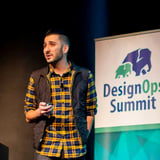Log in or create a free Rosenverse account to watch this video.
Log in Create free account100s of community videos are available to free members. Conference talks are generally available to Gold members.
Summary
If you’re interested in seeing the impact user experience designers can have on products tackling climate change, please join us for a free “show and tell” session. Moderated by Michael Leggett, we’ll hear from Manos Saratsis from Station A, Marissa Cui from MIT, and Rachel He from Stripe. They’ll recount the problems, their design solutions, and what they learned along the way.
Key Insights
-
•
Frontier uses an Advanced Market Commitment model inspired by vaccine development to catalyze carbon removal funding.
-
•
There is a fundamental tension in design between creating emotionally compelling narratives and providing dense, actionable data for experts.
-
•
Carbon removal technology is expensive and in early stages, requiring catalytic investments from buyers like Stripe and Frontier.
-
•
Stripe Climate targets SMBs who want to contribute to carbon removal but have limited climate expertise and resources.
-
•
Making complex carbon removal impact data relatable (e.g., equating CO2 removal to driving or flying metrics) improves user engagement.
-
•
Station A employs patented AI to grade buildings’ clean energy potential using only address input, lowering barriers to entry.
-
•
Familiar interfaces like spreadsheets help users integrate new climate tech tools into existing workflows.
-
•
Refreshing and updating data over time keeps users engaged and helps them track building decarbonization progress.
-
•
Visual storytelling enhances trust and excitement by connecting users directly to funded climate projects and technologies.
-
•
Providing users with sharable, customizable climate impact narratives supports advocacy and internal stakeholder engagement.
Notable Quotes
"The real value is getting to hear from each other and demystifying what’s possible and what’s going on."
"I always want to see the work, the design iterations, not just the finished product."
"Carbon removal is necessary to hit climate goals because reducing emissions alone won’t be enough."
"There’s a tension between showing urgency emotionally and delivering detailed data practically in one product."
"Most traditional offsets go for five to ten dollars per ton; we spent up to seven seventy-five to catalyze new solutions."
"Users want to feel that their dollars are making a difference and want clear storytelling about their impact."
"We built a carbon removal dashboard that turned complex data into immersive stories accessible to general audiences."
"You don’t need a lot of upfront data; we predict energy usage with AI from just a building’s address."
"We meet users where they are by integrating with tools they already know, like spreadsheets."
"The key is leading with simplicity and educating users over time to create lasting value."
Or choose a question:
















More Videos

"For the first time, I was able to advocate for funding directly for the research function at high executive levels."
Nalini KotamrajuResearch After UX
March 25, 2024

"If you want to go fast, go alone; if you want to go far, go together."
Dean BroadleyNot Black Enough to be White
January 8, 2024

"When we start changing our behavior, we start changing the voices and behavior around us."
Denise Jacobs Nancy Douyon Renee Reid Lisa WelchmanInteractive Keynote: Social Change by Design
January 8, 2024

"People problems find their way to design ops because we’re known problem solvers and people run to us when morale is low."
Kim Fellman CohenMeasuring the Designer Experience
October 23, 2019

"Every major brand has a dark side brought to you by design on purpose, 40 hours a week."
George AyeThat Quiet Little Voice: When Design and Ethics Collide
November 16, 2022

"You need to be the connector between people trying to drive decisions and others influencing them."
Nathan CurtisBeyond the Toolkit: Spreading a System Across People & Products
June 9, 2016

"There is an enormous amount of diversity in the real estate agent community, from demographics to technology savvy to regional differences."
Greg PetroffThe Compass Mission
March 10, 2021

"Culture is the sticky glue holding us together but flexible enough to allow us to move in new directions."
Chloe Amos-EdkinsA Cultural Approach: Research in the Context of Glocalisation
March 27, 2023

"The new site had a 19% dropout rate compared to 32% on the old site, showing clear improvement."
Mackenzie Cockram Sara Branco Cunha Ian FranklinIntegrating Qualitative and Quantitative Research from Discovery to Live
December 16, 2022



















